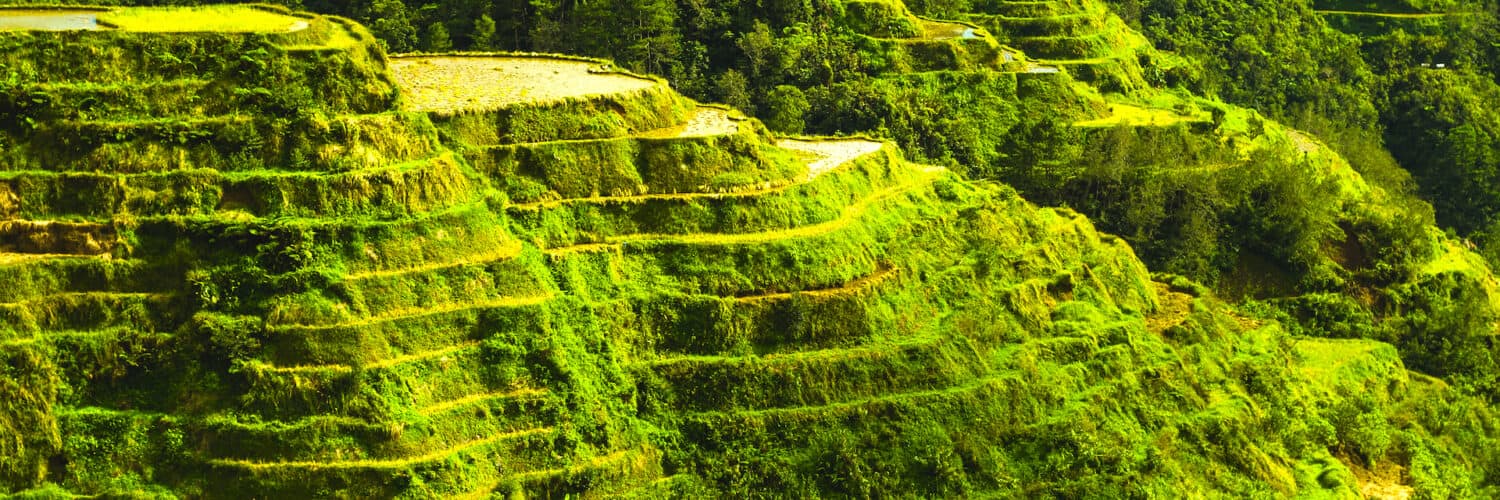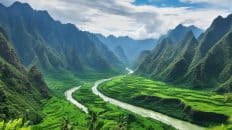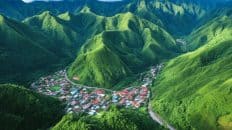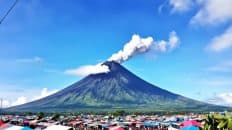Banaue, Philippines:
A Mosaic of Natural Splendor and Cultural Heritage
Nestled within the rugged terrains of the Northern Philippines lies a masterpiece sculpted by the indigenous people thousands of years ago: Banaue. Known primarily for its iconic rice terraces, this town presents a harmonious blend of natural beauty and rich cultural traditions. The Banaue Rice Terraces, often referred to as the “Eighth Wonder of the World”, are not just agricultural plots but a testament to the sheer human will, skill, and dedication.
The Ethereal Banaue Rice Terraces
Carved into the mountains of Ifugao, the Banaue Rice Terraces resemble steps leading to the sky. Spanning over 10,000 square kilometers, these terraces were hand-carved by the indigenous Ifugao people approximately 2,000 years ago without the aid of modern machinery. Their primary purpose was to create flat plots for rice cultivation on the rugged mountainous terrains.
Over millennia, the terraces have not only served as agricultural plots but also played a vital role in conserving the natural landscape, preventing erosion, and maintaining the region’s biodiversity. It’s a magnificent interplay of human need and environmental sustainability, illustrating the symbiotic relationship between humans and nature.
Cultural Epicenter of the Ifugao
Banaue serves as the cultural heart of the Ifugao people, with traditions deeply intertwined with the terraces. The age-old techniques of terrace farming passed down through generations, are an essential aspect of their cultural identity. Festivals, dances, and rituals revolve around the agricultural cycles of planting and harvesting.
The ‘Hudhud’ chants, traditionally sung during rice cultivation and harvesting, echo the tales of ancestral heroes, love, tragedy, and the relationship with nature. In 2001, UNESCO recognized these chants as a Masterpiece of the Oral and Intangible Heritage of Humanity, reinforcing the cultural significance of the region.
Beyond the Terraces: Nature’s Bounty
While the rice terraces are the show-stoppers, Banaue’s natural allure doesn’t stop there. The region is home to cascading waterfalls, meandering rivers, and dense forests teeming with diverse flora and fauna. The Tappiya Waterfall, a short trek from the terraces, offers a refreshing escape with its turquoise waters set against the backdrop of green mountains.
Banaue’s high-altitude setting provides it with a cool climate, making it an ideal destination for treks and hikes. Routes like the Batad Trail challenge the seasoned trekker, while the viewpoints at the Main Banaue Viewpoint and the Hiwang Native House offer panoramic vistas for those seeking a less strenuous experience.
Sustainable Tourism: A Shared Responsibility
The influx of global tourists has brought prosperity but also challenges to Banaue. While tourism has opened avenues for local businesses and increased awareness about the cultural significance of the region, it has also led to concerns over environmental degradation and cultural erosion.
Efforts are ongoing to strike a balance. Locals are engaged in initiatives to preserve their heritage – from maintaining the terraces to keeping their traditions alive. Tourists can contribute by opting for eco-friendly accommodations, respecting local customs, and traveling with operators committed to sustainable practices.
A Culinary Adventure
No experience of Banaue would be complete without indulging in the local cuisine. The region offers a myriad of flavors, with dishes like ‘Pinikpikan’ (a chicken stew), and ‘Biko’ (a rice cake) that are as authentic as they come. Most of the ingredients are sourced locally, ensuring fresh, organic meals that offer a genuine taste of Banaue’s bountiful produce.
Banaue, with its majestic rice terraces and rich cultural tapestry, invites travelers to immerse themselves in a world where nature and culture coalesce beautifully. As one walks along the ancient stone walls or listens to the melodious Hudhud chants, it becomes evident that Banaue is more than just a travel destination – it’s a journey back in time, a testament to human resilience, and a living museum of a culture that has thrived against all odds.
For those willing to delve deeper, beyond the picturesque postcard images, Banaue offers a profound lesson in sustainability, resilience, and the timeless bond between humans and their environment.
Destinations like Banaue remind us of the enduring legacies of our ancestors and the importance of preserving them for future generations. When planning your next travel, consider this mesmerizing town in the Philippines, and become a part of its ongoing story.
1. Why Drive to Banaue?
The allure of taking a car to Banaue rests in the freedom and flexibility it offers. Unlike being constrained by bus schedules or group tours, driving allows travelers to take the journey at their own pace.
- Scenic Routes: The roads leading to Banaue are dotted with panoramic views, quaint towns, and hidden gems waiting to be discovered.
- Flexibility: Want to stop at a viewpoint for an hour? Or maybe discover a local eatery on the way? With a car, you’re the master of your schedule.
- Comfort: Especially if traveling with family or in a group, the space and privacy of a personal vehicle can make the journey much more enjoyable.
2. The Journey to Banaue: What to Expect
The drive to Banaue from Manila, the capital city of the Philippines, typically takes around 8-10 hours. The Nueva Vizcaya-Ifugao-Mountain Province Road is the main route that connects Banaue to other parts of the country. As you ascend the mountainous terrains, expect winding roads, sharp curves, and occasional patches of rough roads.
However, the vistas more than compensate for the long journey. Verdant mountains, cascading waterfalls, and the occasional sight of the majestic rice terraces offer a visual treat.
3. Key Stops and Sights
Driving to Banaue offers a unique opportunity to make unplanned detours and enjoy spontaneous discoveries. Here are some key attractions you shouldn’t miss:
- Banaue Rice Terraces: A UNESCO World Heritage Site, these 2,000-year-old terraces were hand-carved into the mountains by the indigenous Ifugao people. Often referred to as the “Eighth Wonder of the World,” their beauty is unparalleled.
- Banaue Viewpoints: Numerous viewpoints like the Main Viewpoint and the Hiwang Viewpoint offer stunning panoramic views of the terraces.
- Tam-an Village: A traditional Ifugao village that gives visitors a glimpse into the indigenous culture and way of life.
- Bangaan Village: Another picturesque village surrounded by rice terraces, where one can interact with locals and witness traditional Ifugao houses.
4. Driving Tips in Banaue
For those unaccustomed to driving in mountainous regions, here are some tips to ensure a safe journey:
- Stay Alert: Watch out for sudden curves, blind spots, and occasional animals crossing the road.
- Know the Road Signs: Familiarize yourself with Philippine road signs, especially those related to hilly terrains.
- Respect Local Traffic: Often, you might encounter local tricycles or even pedestrians. Always be patient and give them the right of way.
- Weather Check: The weather can be unpredictable. Check forecasts and avoid driving during heavy rain or fog.
5. Local Etiquette and Sustainable Travel
When traveling to Banaue, remember that you’re visiting the home of the Ifugao people. Always be respectful and follow these guidelines:
- Ask Before Clicking: Always ask for permission before taking photos, especially of the locals.
- Tread Lightly: When walking on the rice terraces, always stick to the pathways to avoid damaging the paddies.
- Support Local: From buying souvenirs to dining, always opt for local businesses to support the community.
6. Beyond Banaue: Extend Your Drive
While Banaue is undoubtedly the highlight, the surrounding regions offer equally mesmerizing attractions. Batad, Sagada, and the Mountain Province are all within driving distance and can be combined into a longer road trip.
Banaue, with its ethereal rice terraces and rich indigenous culture, offers a travel experience like no other. And while reaching this remote wonder can be a challenge, doing it by car transforms the journey into an adventure in itself. By driving, you not only get to witness the beauty of Banaue but also discover the countless hidden treasures that lie along the way. So, rev up your engines, set the playlist, and embark on a road trip to one of the Philippines’ most cherished destinations.


















Add comment